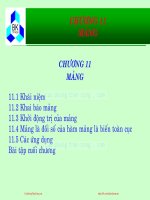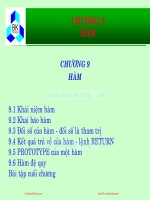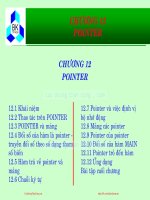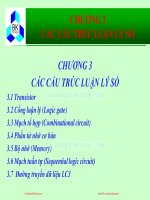Slide hệ thống máy tính và ngôn ngữ lập trình c chương 4 isa
Bạn đang xem bản rút gọn của tài liệu. Xem và tải ngay bản đầy đủ của tài liệu tại đây (381.11 KB, 16 trang )
The Stored Program Computer
1943: ENIAC
• Presper Eckert and John Mauchly -- first general electronic computer.
(or was it John V. Atanasoff in 1939?)
• Hard-wired program -- settings of dials and switches.
Chapter 4 - ISA
1944: Beginnings of EDVAC
• among other improvements, includes program stored in memory
1.The
1
The Von Neumann
Model
1945: John von Neumann
• wrote a report on the stored program concept,
known as the First Draft of a Report on EDVAC
The basic structure proposed in the draft became known
as the “von Neumann machine” (or model).
• a memory, containing instructions and data
• a processing unit, for performing arithmetic and logical operations
• a control unit, for interpreting instructions
For more history, see />
4-2
Von Neumann Model
Memory
2k x m array of stored bits
Address
MEMORY
MAR
MDR
INPUT
Keyboard
Mouse
Scanner
Disk
• unique (k-bit) identifier of location
OUTPUT
PROCESSING UNIT
ALU
TEMP
Contents
Monitor
Printer
LED
Disk
• m-bit value stored in location
Basic Operations:
LOAD
• read a value from a memory location
CONTROL UNIT
PC
0000
0001
0010
0011
0100
0101
0110
1101
1110
1111
00101101
•
•
•
10100010
STORE
IR
• write a value to a memory location
4-3
4-4
1
CuuDuongThanCong.com
/>
Interface to Memory
Processing Unit
How does processing unit get data to/from memory?
MAR: Memory Address Register
MEMORY
MDR: Memory Data Register
Functional Units
MAR
• ALU = Arithmetic and Logic Unit
• could have many functional units.
some of them special-purpose
(multiply, square root, …)
• LC-3 performs ADD, AND, NOT
MDR
To LOAD a location (A):
PROCESSING UNIT
TEMP
ALU
Registers
1. Write the address (A) into the MAR.
2. Send a “read” signal to the memory.
3. Read the data from MDR.
• Small, temporary storage
• Operands and results of functional units
• LC-3 has eight registers (R0, …, R7), each 16 bits wide
To STORE a value (X) to a location (A):
Word Size
1. Write the data (X) to the MDR.
2. Write the address (A) into the MAR.
3. Send a “write” signal to the memory.
• number of bits normally processed by ALU in one instruction
• also width of registers
• LC-3 is 16 bits
4-5
4-6
Input and Output
Control Unit
Devices for getting data into and out of computer
memory
Orchestrates execution of the program
Each device has its own interface,
usually a set of registers like the
memory’s MAR and MDR
INPUT
OUTPUT
Keyboard
Mouse
Scanner
Disk
Monitor
Printer
LED
Disk
CONTROL UNIT
PC
IR
Instruction Register (IR) contains the current instruction.
Program Counter (PC) contains the address
of the next instruction to be executed.
Control unit:
• LC-3 supports keyboard (input) and monitor (output)
• keyboard: data register (KBDR) and status register (KBSR)
• monitor: data register (DDR) and status register (DSR)
• reads an instruction from memory
Some devices provide both input and output
¾ the instruction’s address is in the PC
• disk, network
• interprets the instruction, generating signals
that tell the other components what to do
Program that controls access to a device is
usually called a driver.
4-7
¾ an instruction may take many machine cycles to complete
4-8
2
CuuDuongThanCong.com
/>
Instruction Processing
Instruction
The instruction is the fundamental unit of work.
Specifies two things:
Fetch instruction from memory
• opcode: operation to be performed
• operands: data/locations to be used for operation
Decode instruction
Execute operation
An instruction is encoded as a sequence of bits.
(Just like data!)
• Often, but not always, instructions have a fixed length,
such as 16 or 32 bits.
• Control unit interprets instruction:
generates sequence of control signals to carry out operation.
• Operation is either executed completely, or not at all.
Store result
A computer’s instructions and their formats is known as its
Instruction Set Architecture (ISA).
E l t address
Evaluate
dd
Fetch operands from memory
4-9
4-10
Example: LC-3 ADD Instruction
Example: LC-3 LDR Instruction
LC-3 has 16-bit instructions.
Load instruction -- reads data from memory
Base + offset mode:
• Each instruction has a four-bit opcode, bits [15:12].
LC-3 has eight registers (R0-R7) for temporary storage.
• add offset to base register -- result is memory address
• load from memory address into destination register
• Sources and destination of ADD are registers.
“Add the contents of R2 to the contents of R6,
and store the result in R6.”
“Add the value 6 to the contents of R3 to form a
memory address. Load the contents of that
memory location to R2.”
4-11
4-12
3
CuuDuongThanCong.com
/>
Instruction Processing: FETCH
Load next instruction (at address stored in PC)
from memory
into Instruction Register (IR).
• Copy contents of PC into MAR.
• Send “read” signal to memory.
• Copy contents of MDR into IR.
Then increment PC, so that it points to
the next instruction in sequence.
• PC becomes PC+1.
Instruction Processing: DECODE
First identify the opcode.
F
• In LC-3, this is always the first four bits of instruction.
• A 4-to-16 decoder asserts a control line corresponding
to the desired opcode.
D
F
D
EA
Depending
p
g on opcode,
p
, identify
y other operands
p
from the remaining bits.
EA
OP
• Example:
¾for LDR, last six bits is offset
¾for ADD, last three bits is source operand #2
OP
EX
S
EX
S
4-13
4-14
Instruction Processing: EVALUATE ADDRESS
Instruction Processing: FETCH OPERANDS
For instructions that require memory access,
compute address used for access.
F
Obtain source operands needed to
perform operation.
F
Examples:
D
Examples:
D
• add offset to base register (as in LDR)
• add offset to PC
• add offset to zero
EA
• load data from memory (LDR)
• read data from register file (ADD)
EA
OP
OP
EX
EX
S
S
4-15
4-16
4
CuuDuongThanCong.com
/>
Instruction Processing: EXECUTE
Instruction Processing: STORE RESULT
Perform the operation,
using the source operands.
F
Write results to destination.
(register or memory)
F
Examples:
D
Examples:
D
• send operands to ALU and assert ADD signal
• do nothing (e.g.,
(e g for loads and stores)
EA
OP
• result of ADD is placed in destination register
• result of memory load is placed in destination register
• for store instruction, data is stored to memory
¾write address to MAR, data to MDR
¾assert WRITE signal to memory
EA
OP
EX
EX
S
S
4-17
4-18
Changing the Sequence of Instructions
Example: LC-3 JMP Instruction
In the FETCH phase,
we increment the Program Counter by 1.
Set the PC to the value contained in a register. This
becomes the address of the next instruction to fetch.
What if we don’t want to always execute the instruction
that follows this one?
• examples: loop, if-then, function call
Need special instructions that change the contents
of the PC.
These are called control instructions.
• jumps are unconditional -- they always change the PC
• branches are conditional -- they change the PC only if
some condition is true (e.g., the result of an ADD is zero)
“Load the contents of R3 into the PC.”
4-19
4-20
5
CuuDuongThanCong.com
/>
Instruction Processing Summary
Control Unit State Diagram
Instructions look just like data -- it’s all interpretation.
The control unit is a state machine. Here is part of a
simplified state diagram for the LC-3:
Three basic kinds of instructions:
• computational instructions (ADD, AND, …)
• data movement instructions (LD, ST, …)
• control instructions (JMP
(JMP, BRnz
BRnz, …))
Six basic phases of instruction processing:
F → D → EA → OP → EX → S
• not all phases are needed by every instruction
• phases may take variable number of machine cycles
4-21
A more complete state diagram is in Appendix C.
It will be more understandable after Chapter 5.
4-22
Instruction Set Architecture
ISA = All of the programmer-visible components
and operations of the computer
2. The LC-3
• memory organization
¾ address space -- how may locations can be addressed?
ắ addressibility -- how many bits per location?
ã register set
ắ how many? what size? how are they used?
ã instruction set
ắ opcodes
¾ data types
¾ addressing modes
ISA provides all information needed for someone that wants to
write a program in machine language
(or translate from a high-level language to machine language).
4-24
6
CuuDuongThanCong.com
/>
LC-3 Overview: Memory and Registers
LC-3 Overview: Instruction Set
Memory
Opcodes
• address space: 216 locations (16-bit addresses)
• addressability: 16 bits
Registers
• temporary storage, accessed in a single machine cycle
¾accessing memory generally takes longer than a single cycle
ã eight general-purpose registers: R0 - R7
ắeach 16 bits wide
ắhow many bits to uniquely identify a register?
ã other registers
¾not directly addressable, but used by (and affected by)
instructions
¾PC (program counter), condition codes
•
•
•
•
•
15 opcodes
Operate instructions: ADD, AND, NOT
Data movement instructions: LD, LDI, LDR, LEA, ST, STR, STI
Control instructions: BR, JSR/JSRR, JMP, RTI, TRAP
some opcodes set/clear condition codes, based on result:
¾N = negative, Z = zero, P = positive (> 0)
Data Types
• 16-bit 2’s complement integer
Addressing Modes
• How is the location of an operand specified?
• non-memory addresses: immediate, register
• memory addresses: PC-relative, indirect, base+offset
4-25
Operate Instructions
4-26
NOT (Register)
Only three operations: ADD, AND, NOT
Source and destination operands are registers
• These instructions do not reference memory.
• ADD and AND can use “immediate” mode,
where one operand
p
is hard-wired into the instruction.
Will show dataflow diagram with each instruction.
• illustrates when and where data moves
to accomplish the desired operation
4-27
Note: Src and Dst
could be the same register.
4-28
7
CuuDuongThanCong.com
/>
ADD/AND (Register)
this zero means “register mode”
ADD/AND (Immediate)
this one means “immediate mode”
Note: Immediate field is
sign-extended.
4-29
4-30
Using Operate Instructions
Data Movement Instructions
With only ADD, AND, NOT…
Load -- read data from memory to register
• LD: PC-relative mode
• LDR: base+offset mode
• LDI: indirect mode
• How do we subtract?
Store -- write data from register to memory
• How do we OR?
• ST
ST: PC-relative
PC l i mode
d
• STR: base+offset mode
• STI: indirect mode
• How do we copy from one register to another?
Load effective address -- compute address,
save in register
• How do we initialize a register to zero?
• LEA: immediate mode
• does not access memory
4-31
4-32
8
CuuDuongThanCong.com
/>
PC-Relative Addressing Mode
LD (PC-Relative)
Want to specify address directly in the instruction
• But an address is 16 bits, and so is an instruction!
• After subtracting 4 bits for opcode
and 3 bits for register, we have 9 bits available for address.
Solution:
• Use the 9 bits as a signed offset from the current PC.
9 bits: − 256 ≤ offset ≤ +255
Can form any address X, such that: PC − 256 ≤ X ≤ PC +255
Remember that PC is incremented as part of the FETCH phase;
This is done before the EVALUATE ADDRESS stage.
4-33
ST (PC-Relative)
4-34
Indirect Addressing Mode
With PC-relative mode, can only address data
within 256 words of the instruction.
• What about the rest of memory?
Solution #1:
• Read address from memory location,
location
then load/store to that address.
First address is generated from PC and IR
(just like PC-relative addressing), then
content of that address is used as target for load/store.
4-35
4-36
9
CuuDuongThanCong.com
/>
LDI (Indirect)
STI (Indirect)
4-37
Base + Offset Addressing Mode
4-38
LDR (Base+Offset)
With PC-relative mode, can only address data
within 256 words of the instruction.
• What about the rest of memory?
Solution #2:
• Use a register to generate a full 16-bit
16 bit address.
address
4 bits for opcode, 3 for src/dest register,
3 bits for base register -- remaining 6 bits are used
as a signed offset.
• Offset is sign-extended before adding to base register.
4-39
4-40
10
CuuDuongThanCong.com
/>
STR (Base+Offset)
Load Effective Address
Computes address like PC-relative (PC plus signed offset)
and stores the result into a register.
Note:
The address is stored in the register,
not the contents of the memory location.
4-41
LEA (Immediate)
4-42
Example
4-43
Address
Instruction
Comments
x30F6
1 1 1 0 0 0 1 1 1 1 1 1 1 1 0 1
R1 ← PC – 3 = x30F4
x30F7
0 0 0 1 0 1 0 0 0 1 1 0 1 1 1 0
R2 ← R1 + 14 = x3102
x30F8
0 0 1 1 0 1 0 1 1 1 1 1 1 0 1 1
M[PC - 5] ← R2
M[x30F4] ← x3102
x30F9
0 1 0 1 0 1 0 0 1 0 1 0 0 0 0 0
R2 ← 0
x30FA
0 0 0 1 0 1 0 0 1 0 1 0 0 1 0 1
R2 ← R2 + 5 = 5
x30FB
0 1 1 1 0 1 0 0 0 1 0 0 1 1 1 0
M[R1+14] ← R2
M[x3102] ← 5
x30FC
1 0 1 0 0 1 1 1 1 1 1 1 0 1 1 1
R3 ← M[M[x30F4]]
R3 ← M[x3102]
R3 ← 5
opcode
4-44
11
CuuDuongThanCong.com
/>
Control Instructions
Condition Codes
Used to alter the sequence of instructions
(by changing the Program Counter)
LC-3 has three condition code registers:
N -- negative
Z -- zero
P -- positive (greater than zero)
Conditional Branch
• branch is taken if a specified condition is true
¾signed offset is added to PC to yield new PC
• else,
l
the
th branch
b
h is
i nott ttaken
k
¾PC is not changed, points to the next sequential instruction
Unconditional Branch (or Jump)
Set by any instruction that writes a value to a register
(ADD, AND, NOT, LD, LDR, LDI, LEA)
Exactly one will be set at all times
• always changes the PC
• Based on the last instruction that altered a register
TRAP
• changes PC to the address of an OS “service routine”
• routine will return control to the next instruction (after TRAP)
4-45
Branch Instruction
4-46
BR (PC-Relative)
Branch specifies one or more condition codes.
If the set bit is specified, the branch is taken.
• PC-relative addressing:
target address is made by adding signed offset (IR[8:0])
to current PC.
• Note: PC has already been incremented by FETCH stage.
• Note: Target must be within 256 words of BR instruction.
If the branch is not taken,
the next sequential instruction is executed.
4-47
What happens if bits [11:9] are all zero? All one?
4-48
12
CuuDuongThanCong.com
/>
Using Branch Instructions
Sample Program
Compute sum of 12 integers.
Numbers start at location x3100. Program starts at location x3000.
R1 ← x3100
R3 ← 0
R2 ← 12
R2=0?
NO
R4
R3
R1
R2
←
←
←
←
M[R1]
R3+R4
R1+1
R2-1
YES
Address
Instruction
Comments
x3000
1 1 1 0 0 0 1 0 1 1 1 1 1 1 1 1
R1 ← x3100 (PC+0xFF)
x3001
0 1 0 1 0 1 1 0 1 1 1 0 0 0 0 0
R3 ← 0
x3002
0 1 0 1 0 1 0 0 1 0 1 0 0 0 0 0
R2 ← 0
x3003
0 0 0 1 0 1 0 0 1 0 1 0 1 1 0 0
R2 ← 12
x3004
0 0 0 0 0 1 0 0 0 0 0 0 0 1 0 1
If Z, goto x300A (PC+5)
x3005
0 1 1 0 1 0 0 0 0 1 0 0 0 0 0 0
Load next value to R4
x3006
0 0 0 1 0 1 1 0 1 1 0 0 0 0 0 1
Add to R3
x3007
0 0 0 1 0 0 1 0 0 1 1 0 0 0 0 1
Increment R1 (pointer)
X3008
0 0 0 1 0 1 0 0 1 0 1 1 1 1 1 1
Decrement R2 (counter)
x3009
0 0 0 0 1 1 1 1 1 1 1 1 1 0 1 0
Goto x3004 (PC-6)
4-49
JMP (Register)
4-50
TRAP
Jump is an unconditional branch -- always taken.
• Target address is the contents of a register.
• Allows any target address.
Calls a service routine, identified by 8-bit “trap vector.”
vector routine
x23
p a character from the keyboard
y
input
x21
output a character to the monitor
x25
halt the program
When routine is done,
PC is set to the instruction following TRAP.
(We’ll talk about how this works later.)
4-51
4-52
13
CuuDuongThanCong.com
/>
Another Example
Flow Chart
Count the occurrences of a character in a file
• Program begins at location x3000
• Read character from keyboard
• Load each character from a “file”
Count = 0
(R2 = 0)
Done?
YES
(R1 ?= EOT)
¾ File is a sequence of memory locations
¾ Starting address of file is stored in the memory location
immediately after the program
Ptr = 1st file character
Convert count to
ASCII character
(R0 = x30, R0 = R2 + R0)
NO
(R3 = M[x3012])
Print count
YES
• If file character equals input character, increment counter
• End of file is indicated by a special ASCII value: EOT (x04)
• At the end, print the number of characters and halt
Match?
NO
((TRAP x21))
(R1 ?= R0)
Input char
from keybd
(TRAP x23)
HALT
(assume there will be less than 10 occurrences of the character)
Incr Count
(TRAP x25)
(R2 = R2 + 1)
Load char from file
(R1 = M[R3])
A special character used to indicate the end of a sequence
is often called a sentinel.
Load next char from file
(R3 = R3 + 1, R1 = M[R3])
• Useful when you don’t know ahead of time how many times
to execute a loop.
4-53
Program (1 of 2)
4-54
Program (2 of 2)
Address
Instruction
Comments
Address
Instruction
Comments
x3000
0 1 0 1 0 1 0 0 1 0 1 0 0 0 0 0
R2 ← 0 (counter)
x300A
0 0 0 1 0 1 0 0 1 0 1 0 0 0 0 1
R2 ← R2 + 1
x3001
0 0 1 0 0 1 1 0 0 0 0 1 0 0 0 0
R3 ← M[x3102] (ptr)
x300B
0 0 0 1 0 1 1 0 1 1 1 0 0 0 0 1
R3 ← R3 + 1
x3002
1 1 1 1 0 0 0 0 0 0 1 0 0 0 1 1
Input to R0 (TRAP x23)
x300C
0 1 1 0 0 0 1 0 1 1 0 0 0 0 0 0
R1 ← M[R3]
x3003
0 1 1 0 0 0 1 0 1 1 0 0 0 0 0 0
R1 ← M[R3]
x300D
0 0 0 0 1 1 1 1 1 1 1 1 0 1 1 0
Goto x3004
x3004
0 0 0 1 1 0 0 0 0 1 1 1 1 1 0 0
R4 ← R1 – 4 (EOT)
x300E
0 0 1 0 0 0 0 0 0 0 0 0 0 1 0 0
R0 ← M[x3013]
x3005
0 0 0 0 0 1 0 0 0 0 0 0 1 0 0 0
If Z, goto x300E
x300F
0 0 0 1 0 0 0 0 0 0 0 0 0 0 1 0
R0 ← R0 + R2
x3006
1 0 0 1 0 0 1 0 0 1 1 1 1 1 1 1
R1 ← NOT R1
x3010
1 1 1 1 0 0 0 0 0 0 1 0 0 0 0 1
Print R0 (TRAP x21)
x3007
0 0 0 1 0 0 1 0 0 1 1 0 0 0 0 1
R1 ← R1 + 1
x3011
1 1 1 1 0 0 0 0 0 0 1 0 0 1 0 1
HALT (TRAP x25)
X3008
0 0 0 1 0 0 1 0 0 1 0 0 0 0 0 0
R1 ← R1 + R0
X3012
Starting Address of File
x3009
0 0 0 0 1 0 1 0 0 0 0 0 0 0 0 1
If N or P, goto x300B
x3013
0 0 0 0 0 0 0 0 0 0 1 1 0 0 0 0
4-55
ASCII x30 (‘0’)
4-56
14
CuuDuongThanCong.com
/>
LC-3
Data Path
Revisited
Data Path Components
Global bus
• special set of wires that carry a 16-bit signal
to many components
• inputs to the bus are “tri-state devices,”
that only place a signal on the bus when they are enabled
• only one (16-bit) signal should be enabled at any time
¾
¾control
t l unit
it decides
d id which
hi h signal
i
l “drives”
“d i
” the
th bus
b
• any number of components can read the bus
¾register only captures bus data if it is write-enabled by the
control unit
Filled arrow
= info to be processed.
Unfilled arrow
= control signal.
Memory
• Control and data registers for memory and I/O devices
• memory: MAR, MDR (also control signal for read/write)
4-57
4-58
Data Path Components
Data Path Components
ALU
PC and PCMUX
• Accepts inputs from register file
and from sign-extended bits from IR (immediate field).
• Output goes to bus.
ắused by condition code logic, register file, memory
ã
Register File
Three inputs to PC, controlled by PCMUX
1. PC+1 – FETCH stage
2. Address adder – BR, JMP
3. bus – TRAP (discussed later)
MAR and MARMUX
• Two read addresses (SR1, SR2), one write address (DR)
• Input from bus
ắresult of ALU operation or memory read
ã Two 16-bit outputs
¾used by ALU, PC, memory address
¾data for store instructions passes through ALU
•
Two inputs to MAR, controlled by MARMUX
1. Address adder – LD/ST, LDR/STR
2. Zero-extended IR[7:0] -- TRAP (discussed later)
4-59
4-60
15
CuuDuongThanCong.com
/>
Data Path Components
Condition Code Logic
• Looks at value on bus and generates N, Z, P signals
• Registers set only when control unit enables them (LD.CC)
¾only certain instructions set the codes
(ADD, AND, NOT, LD, LDI, LDR, LEA)
Control Unit – Finite State Machine
• On each machine cycle, changes control signals for next phase
of instruction processing
¾who drives the bus? (GatePC, GateALU, …)
¾which registers are write enabled? (LD.IR, LD.REG, …)
¾which operation should ALU perform? (ALUK)
ắ
ã Logic includes decoder for opcode, etc.
4-61
16
CuuDuongThanCong.com
/>









